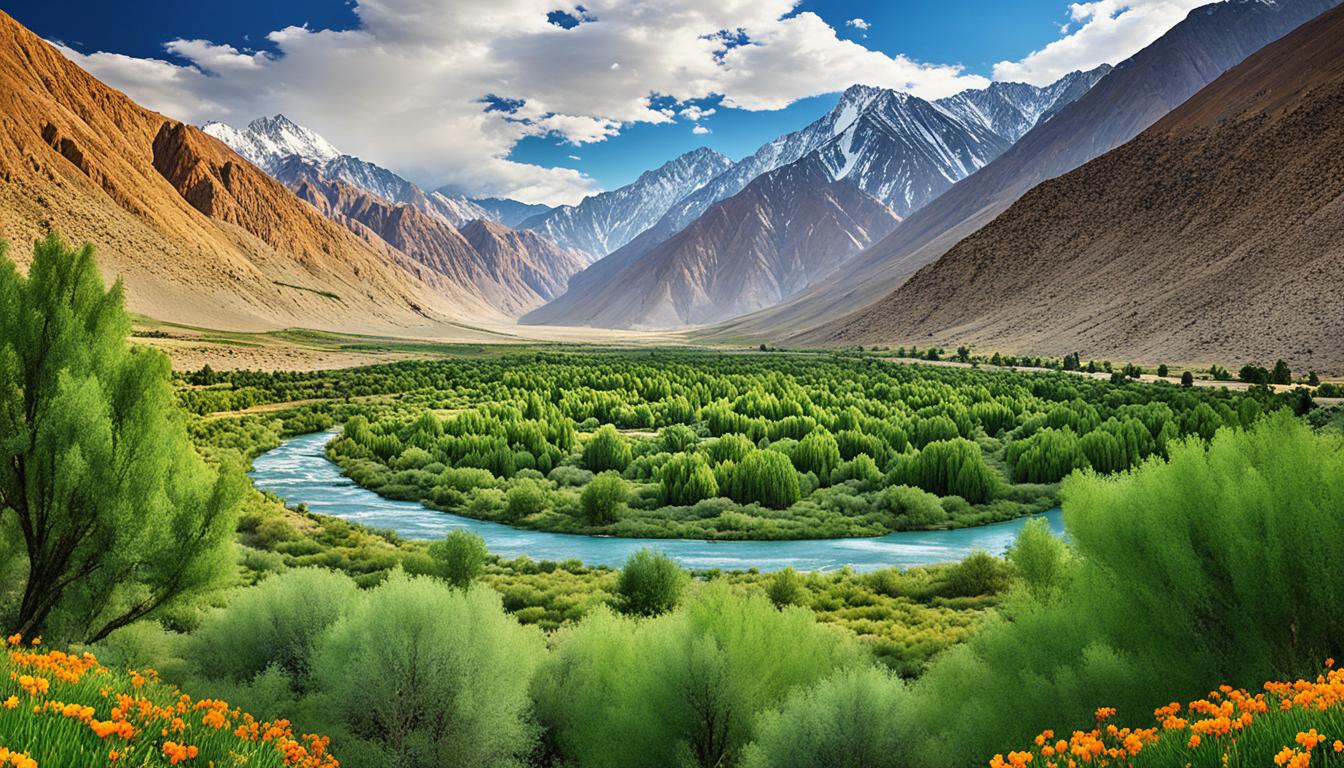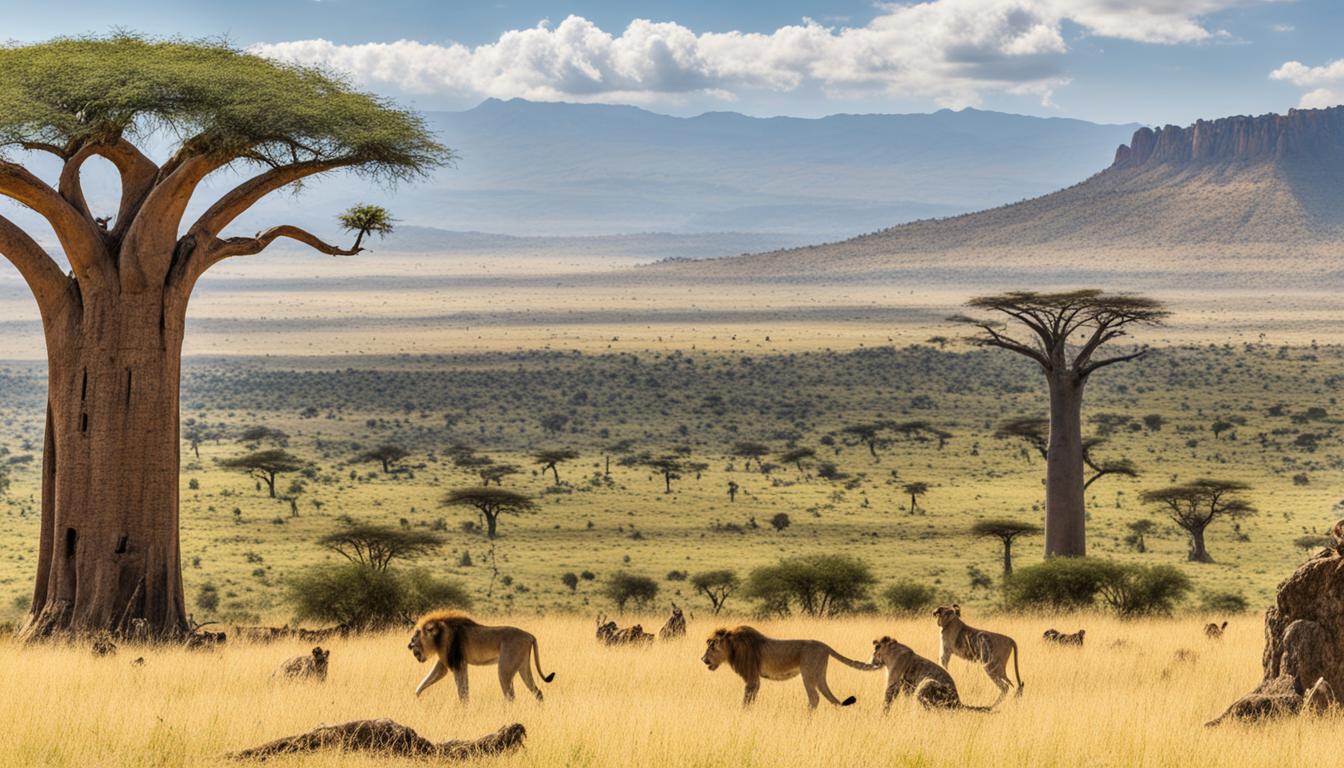Tanzania Biodiversity and the Built Environment
Tanzania, a country blessed with extraordinary natural beauty and diverse wildlife, is home to a remarkable array of flora and fauna. With its stunning landscapes and abundant biodiversity, Tanzania stands as a prime example of the delicate ecological balance between the built environment and the preservation of nature.
Conservation and sustainable development are at the heart of Tanzania’s approach to urban planning and architecture. Recognizing the importance of preserving ecological harmony, the country has taken significant steps to ensure the protection of its wildlife sanctuaries and natural habitats. From construction guidelines to environmental preservation efforts, Tanzania is committed to striking a balance between development and the well-being of its unique ecosystems.
Key Takeaways:
- Tanzania is a mega-biodiversity rich country with over 14,500 known species.
- The country faces challenges such as habitat loss and unsustainable resource management.
- The Vice President’s Office coordinates biodiversity conservation efforts and implements policies.
- Tanzania has various types of protected areas, including national parks and game reserves.
- The country aims to strengthen institutional capacity and combat poaching through partnerships and support.
Key Policies and Governance Approach
In Tanzania, biodiversity conservation is a priority, and it is overseen by the Vice President’s Office, specifically the Division of the Environment (VPO-DoE). This office plays a crucial role in enforcing the implementation of various strategies, guidelines, policies, and legislation to safeguard the country’s abundant biodiversity.
With a strong focus on sustainable development and ecological balance, Tanzania has made significant progress in expanding protected areas. Between 1995 and 2014, the country saw an impressive increase of over 20% in the total protected land area.
Tanzania boasts a diverse network of protected areas, including national parks, biosphere reserves, game reserves, wildlife management areas, forests, marine parks, and Ramsar Sites. These protected areas serve as crucial habitats for a wide range of plant and animal species.
To ensure effective biodiversity conservation, Tanzania has put in place key legislation such as the Environmental Management Act, Wildlife Conservation Act, and wildlife management area regulations. These laws provide the legal framework for protecting and managing the country’s natural resources.
The National Environment Management Council (NEMC) and wildlife management support units play a vital role in the implementation of biodiversity conservation policies in Tanzania. These institutions work closely with local communities and stakeholders to promote sustainable practices and ensure the effective management of protected areas.
Biodiversity Conservation Strategies
- Strengthening legislation to enhance biodiversity protection
- Establishing wildlife corridors to promote species connectivity
- Encouraging community-led conservation initiatives
- Implementing sustainable agriculture practices to minimize habitat destruction
- Enhancing environmental education and awareness
“Conserving biodiversity is not just about protecting individual species; it is about safeguarding the delicate balance of ecosystems which ultimately sustains all life forms.” – Vice President’s Office
Tanzania is committed to promoting sustainable resource management and the long-term conservation of its rich biodiversity. By implementing effective policies, collaborating with stakeholders, and raising awareness, Tanzania aims to ensure the protection and preservation of its unique natural heritage for current and future generations.
Types of Protected Areas in Tanzania
Tanzania boasts a diverse range of protected areas that play a crucial role in biodiversity conservation. These protected areas include:
- National Parks: Covering a substantial area of 52,300 square kilometers, national parks in Tanzania are designated for the protection and preservation of the country’s unique flora and fauna. These parks provide vital habitats for a wide variety of wildlife species, offering visitors the opportunity to experience Tanzania’s natural beauty up close. Some well-known national parks include Serengeti National Park, Ngorongoro Conservation Area, and Tarangire National Park.
- Biosphere Reserves: Tanzania is home to four biosphere reserves, spanning a total area of 5,016 square kilometers. These reserves are designed to promote sustainable development while conserving biodiversity. They serve as living laboratories for scientific research, environmental education, and community involvement in resource management.
- Game Reserves: Encompassing a vast area of 73,002 square kilometers, game reserves in Tanzania are dedicated to protecting and conserving wildlife habitats. These reserves provide a sanctuary for numerous terrestrial and aquatic species, allowing them to thrive in their natural environments.
- Wildlife Management Areas: Covering an expansive area of 162,894 square kilometers, wildlife management areas in Tanzania are essential for the sustainable use of natural resources. These areas aim to strike a balance between conservation and the livelihoods of local communities, promoting community-based conservation initiatives and responsible tourism.
- Forests: Tanzania is rich in forest cover, with 34 forests spanning a total area of 81,523 square kilometers. These forests are vital for maintaining ecological balance and provide essential habitats for various plant and animal species.
- Marine Parks: With seven marine parks spanning a total area of 3,293 square kilometers, Tanzania’s marine parks are dedicated to the conservation and sustainable management of marine ecosystems. These parks protect critical habitats, such as coral reefs and seagrass beds, supporting a diverse array of marine life.
- Ramsar Sites: Tanzania is home to eight Ramsar Sites, which are internationally recognized wetland areas of significant ecological importance. These sites provide habitat for various migratory bird species and support the ecological health of the surrounding landscapes.
Each type of protected area in Tanzania plays a crucial role in preserving the country’s rich biodiversity and ensuring the long-term sustainability of its ecosystems.
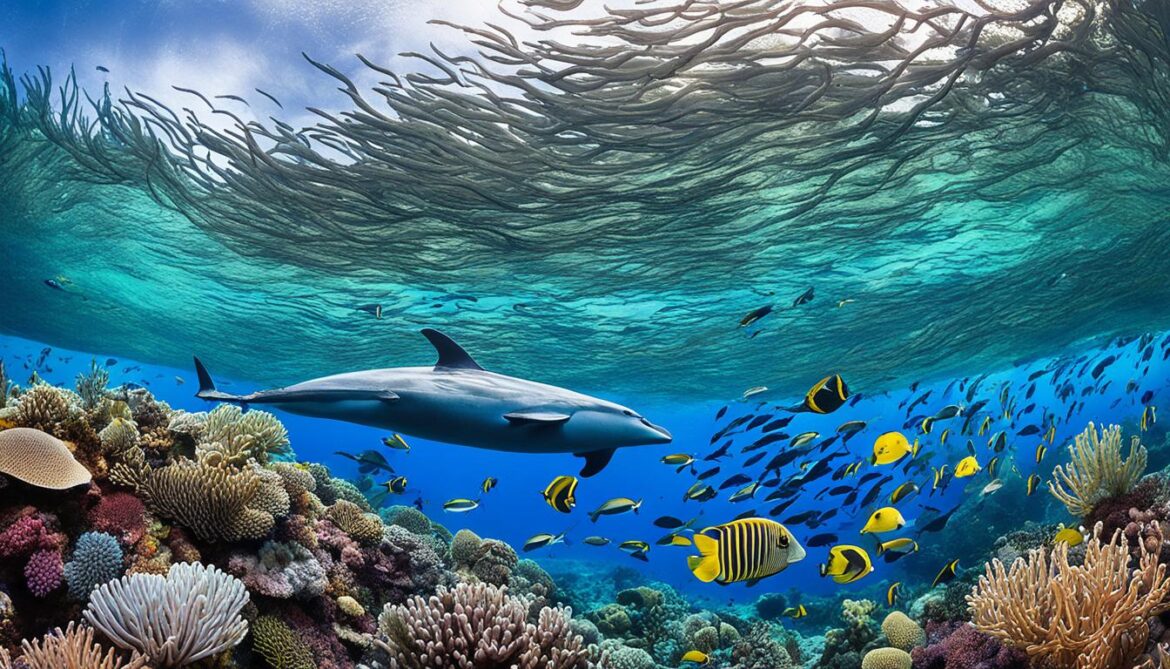
Biodiversity in Tanzania’s Protected Areas
The protected areas in Tanzania are home to a remarkable array of flora and fauna. These areas support a broad range of terrestrial and aquatic ecosystems, providing habitats for iconic species such as elephants, lions, giraffes, zebras, and numerous bird species. The marine parks along the Tanzanian coast harbor colorful coral reefs, sea turtles, dolphins, and a vast number of fish species. The diversity of species and ecosystems found within Tanzania’s protected areas makes them valuable assets for both conservation and ecotourism.
| Protected Area Type | Area (square kilometers) |
|---|---|
| National Parks | 52,300 |
| Biosphere Reserves | 5,016 |
| Game Reserves | 73,002 |
| Wildlife Management Areas | 162,894 |
| Forests | 81,523 |
| Marine Parks | 3,293 |
| Ramsar Sites | N/A |
Tanzania’s commitment to protecting its diverse ecosystems through these various types of protected areas is crucial for the preservation of its unique biodiversity for future generations to enjoy.
Successes and Remaining Challenges
While Tanzania has implemented sound policies related to natural resource management, the country still faces challenges in achieving sustainable conservation. One of the key challenges is the presence of weak institutions that hinder the effective implementation of conservation strategies. These weak institutions lack the necessary capacity and resources to enforce regulations and address conservation issues adequately.
The unsustainable management of resources is another significant challenge. Overexploitation of forests for firewood by local communities has led to resource depletion and environmental degradation. This unsustainable resource management practices pose a threat to the delicate balance of ecosystems and the preservation of biodiversity.
Poaching is another major challenge that Tanzania faces. Weak institutions and inadequate enforcement contribute to the escalation of poaching activities, putting immense pressure on wildlife populations and posing a threat to both ecosystems and the tourism industry.
Addressing these challenges requires improving institutional capacity for planning and enforcement, as well as strengthening coordination between different agencies. It is imperative to involve stakeholders and provide adequate incentives for sustainable resource management.
Despite these challenges, Tanzania has made significant progress in biodiversity conservation through the implementation of policies and strategies. However, more work needs to be done to overcome the remaining obstacles and ensure the long-term preservation of Tanzania’s natural heritage.
Tanzania’s Institutional Capacity
Tanzania’s weak institutional capacity limits the effective implementation of conservation policies. These institutions lack the necessary resources, expertise, and coordination to enforce regulations and address conservation challenges. The limited institutional capacity is evident in inadequate data quality and analysis, which hampers evidence-based decision-making.
Improving institutional capacity is crucial for overcoming these challenges. This involves providing training and resources to relevant agencies, enhancing data collection and analysis capabilities, and fostering collaboration between different institutions working towards conservation goals.
Unsustainable Resource Management
The overexploitation of forests for firewood is a significant aspect of unsustainable resource management in Tanzania. Local communities heavily rely on forests for fuel, leading to deforestation and habitat loss. This not only threatens the biodiversity within forests but also disrupts the ecological balance of ecosystems.
To address this issue, alternative sources of energy need to be promoted, while sustainable forest management practices should be implemented. Efforts should focus on educating local communities about the importance of sustainable resource use and providing them with viable alternatives for their energy needs.
Combatting Poaching
Poaching poses a significant threat to Tanzania’s biodiversity and the tourism industry. Weak institutions and inadequate enforcement contribute to the persistence of poaching activities. Effective measures are needed to tackle this problem, including strengthening law enforcement, implementing rigorous monitoring systems, and combating corruption.
Collaboration with international organizations and neighboring countries can also play a crucial role in addressing wildlife trafficking and dismantling international criminal networks involved in poaching activities.
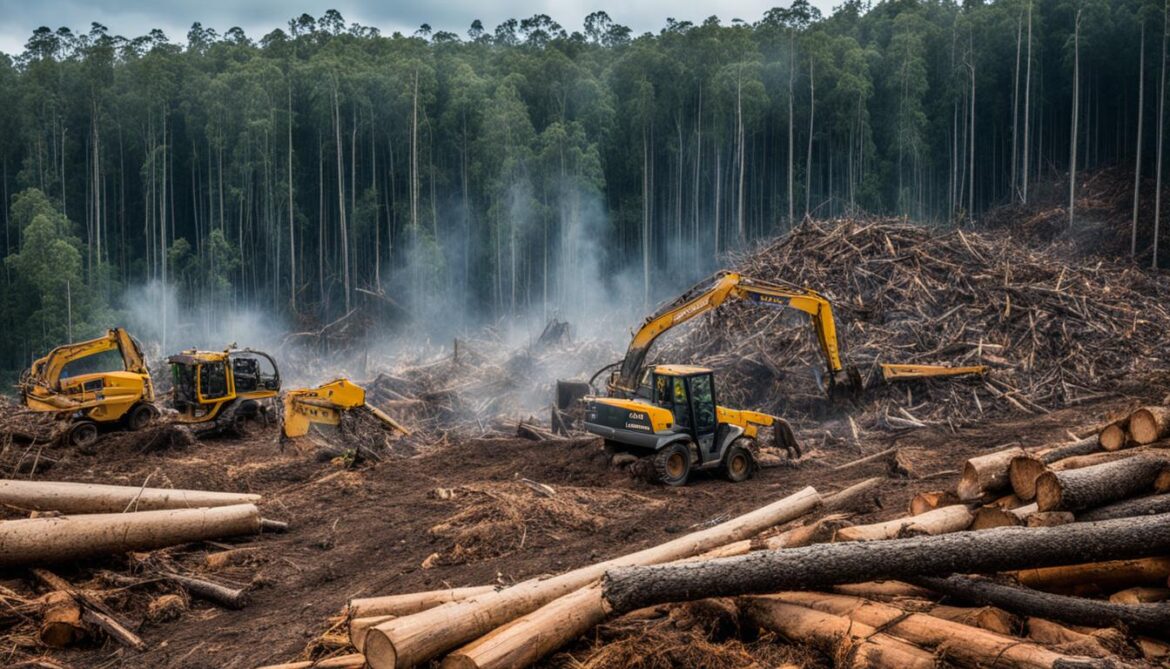
Weak Institutional Capacity and Poaching
One of the major challenges in Tanzania is the weak institutional capacity to effectively implement conservation policies and initiatives. The lack of well-trained personnel in key government agencies responsible for natural resource management hampers their ability to enforce regulations and address conservation issues adequately. This results in ineffective monitoring and enforcement, allowing for illegal activities such as poaching and unsustainable resource exploitation to persist.
Poaching remains a significant threat to Tanzania’s biodiversity, with weak law enforcement, corruption, and the presence of international criminal networks exacerbating the problem. The illegal hunting of protected species, driven by high demand for animal products, poses a severe risk to the country’s wildlife populations and ecological balance. Poachers often target iconic species such as elephants and rhinos for their ivory, while bushmeat hunting contributes to the depletion of various animal populations.
The government of Tanzania recognizes the importance of addressing the poaching crisis and has taken measures to combat illegal activities. Efforts are being made to strengthen enforcement through increased patrols, improved surveillance technologies, and collaborative partnerships with local communities, non-governmental organizations, and international bodies. However, weak institutional capacity and limited resources remain significant barriers to effectively addressing poaching and achieving long-term conservation goals.
It is essential for Tanzania to prioritize capacity building initiatives, invest in training programs for law enforcement agencies, and strengthen collaboration between different stakeholders involved in wildlife protection. This includes fostering cooperation with neighboring countries to combat cross-border wildlife trafficking networks and enhance monitoring and intelligence sharing.
Ineffective monitoring and enforcement, coupled with weak institutional capacity, allow for illegal activities such as poaching to persist in Tanzania.
Table
| Poaching Impact | Consequences |
|---|---|
| Reduced wildlife populations | Loss of biodiversity and ecological disruption |
| Decline in species richness | Threat to endangered and iconic species |
| Economic losses in tourism | Impacted revenue and job opportunities |
| Destabilization of ecosystems | Loss of natural balance and ecosystem services |

The table above highlights the consequences of poaching on Tanzania’s biodiversity and ecosystem. The relentless pursuit of illegal activities disrupts the delicate balance of ecosystems, leading to a decline in species richness and endangering iconic wildlife. It also inflicts economic losses in the tourism sector, impacting the country’s revenue and job opportunities. Furthermore, poaching destabilizes ecosystems, resulting in the loss of valuable natural balances and essential ecosystem services.
Unsustainable Use of Natural Resources
One of the critical challenges facing Tanzania is the unsustainable use of natural resources, specifically the overexploitation of forests for firewood. In many rural communities, forests are heavily relied upon as a source of energy, leading to deforestation and major habitat loss. This widespread practice not only disrupts the delicate balance of ecosystems but also has detrimental effects on the biodiversity within forests, contributing to the decline of certain species and the overall degradation of Tanzania’s natural landscapes.
“The overexploitation of forests for firewood poses a significant threat to Tanzania’s environment and biodiversity. It is crucial that we address this issue to preserve our natural heritage for future generations.”
Forests play a vital role in maintaining ecological balance by acting as habitats for various species, regulating water cycles, and mitigating climate change. However, the ongoing overexploitation of forests puts all these essential functions at risk. Deforestation results in the loss of important habitats for wildlife and reduces the availability of resources that communities rely on for their livelihoods.
To comprehend the scale of deforestation and habitat loss, let’s consider some alarming statistics:
| Statistic | Extent |
|---|---|
| Forest area lost in the past decade | 2.6 million hectares |
| Annual deforestation rate | 0.95% |
| Estimated loss of tree cover by 2030 | about 1.52 million hectares |
This data illustrates the urgency of addressing the issue of overexploitation of forests in Tanzania. Without intervention, the delicate balance of ecosystems will continue to be disrupted, leading to further habitat loss, the decline of wildlife populations, and severe environmental consequences.
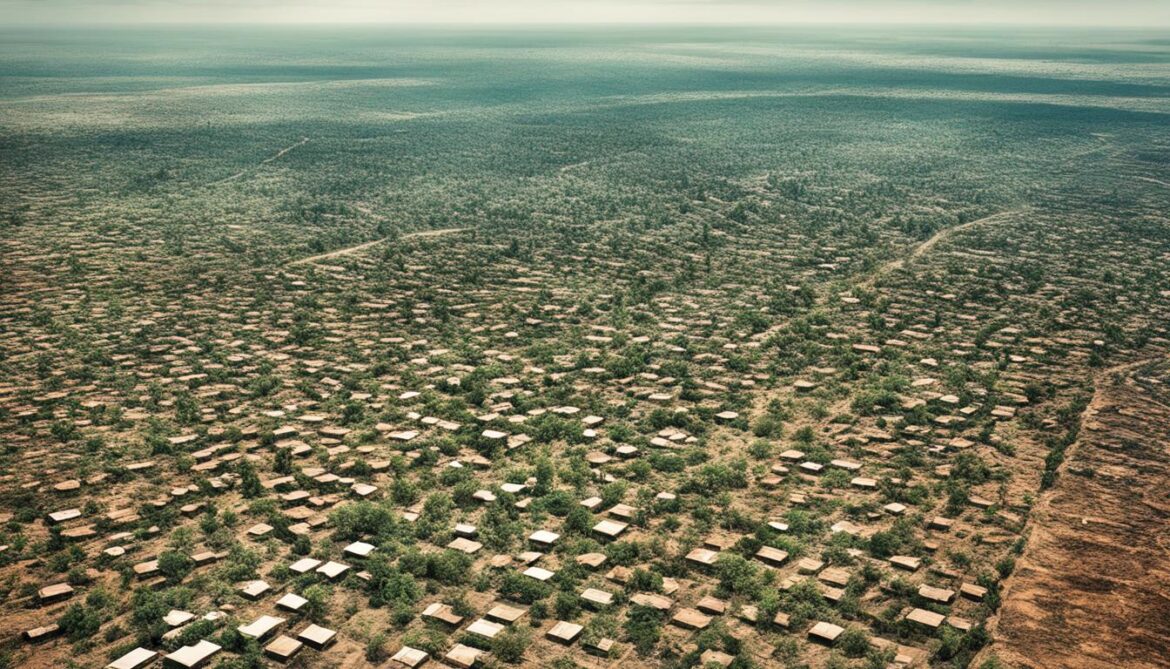
It is crucial for Tanzania to develop and implement sustainable strategies for managing forests, promoting alternative sources of energy, and raising awareness about the importance of preserving the country’s natural resources. By implementing stricter regulations and promoting sustainable practices, Tanzania can strive towards achieving a harmonious balance between human needs and environmental preservation.
Initiatives and Development Plans
Tanzania is deeply committed to the conservation of its diverse biodiversity and the promotion of sustainable development. To achieve these goals, the country has implemented a range of initiatives and development plans to address the challenges facing its natural resources.
National Biodiversity Strategies and Action Plans
In order to tackle biodiversity challenges effectively, Tanzania has developed and implemented comprehensive national biodiversity strategies and action plans. These strategic documents outline specific strategies and actions aimed at conserving and protecting Tanzania’s rich biodiversity. By following these plans, Tanzania strives to strike a balance between sustainable development and nature conservation.
Marine Protected Areas
Recognizing the significance of marine ecosystems, Tanzania has taken the initiative to establish marine protected areas in biodiversity hotspots. These areas serve as crucial sanctuaries for marine life, protecting habitats, and preserving the delicate balance of coastal ecosystems. The creation of marine protected areas demonstrates Tanzania’s commitment to safeguarding its marine biodiversity.
Expansion of Wildlife Management Areas
Tanzania is actively expanding its network of wildlife management areas to ensure the effective conservation of its diverse wildlife populations. These areas provide crucial habitats for a wide range of species, including endangered and endemic wildlife. By expanding these areas, Tanzania aims to enhance wildlife protection and habitat preservation.
Promotion of New Protected Areas
In addition to existing protected areas, Tanzania is actively promoting the creation of new protected areas. This includes the identification and designation of areas with significant ecological value that require conservation measures. Creating new protected areas enables Tanzania to safeguard important ecosystems, protect endangered species, and preserve biodiversity for future generations.
Review of Policies and Strategies
Tanzania recognizes the importance of regularly reviewing its policies and strategies for managing protected areas. By conducting comprehensive reviews, the country can identify areas in need of improvement and develop new approaches to biodiversity conservation. This adaptive management approach allows Tanzania to stay current with changing environmental conditions and challenges.
Regional and International Agreements
Tanzania actively participates in regional and international agreements on biodiversity conservation. By engaging in these agreements, Tanzania collaborates with other nations to develop and implement effective strategies for preserving biodiversity on a global scale. Through partnerships and cooperation, Tanzania aims to share knowledge and best practices while ensuring the long-term conservation of its natural resources.

Overall, Tanzania’s initiatives and development plans demonstrate a strong commitment to biodiversity conservation and sustainable development. Through the implementation of national biodiversity strategies, the establishment of marine protected areas, the expansion of wildlife management areas, and the promotion of new protected areas, Tanzania strives to protect its natural heritage for the benefit of present and future generations.
Goals and Ambitions
Tanzania has set forth several ambitious objectives to preserve and sustainably manage its biodiversity. These objectives encompass a range of initiatives aimed at protecting marine and wildlife habitats, promoting new protected areas, and implementing policies for sustainable resource management.
1. Establishment of Marine Protected Areas
Tanzania aims to establish new marine protected areas to safeguard its diverse marine ecosystems and protect vulnerable species. These designated areas will help preserve critical habitats, such as coral reefs and seagrass meadows, and maintain healthy marine biodiversity.
2. Expansion of Wildlife Management Areas
The expansion of wildlife management areas is a priority for Tanzania, as it increases the protected habitat for various wildlife species. By designating and managing these areas, Tanzania enhances habitat connectivity and ensures the sustainable conservation of its terrestrial biodiversity.
3. Promotion of New Protected Areas
Tanzania is actively working to promote the creation of new protected areas across the country. These areas will serve as sanctuaries for endangered species and contribute to the overall preservation of Tanzania’s rich biodiversity. The establishment of new protected areas is an integral part of Tanzania’s commitment to nature conservation and sustainable development.
4. Review of Policies and Strategies
Tanzania recognizes the importance of regularly reviewing and updating policies and strategies related to protected areas and biodiversity conservation. Through these reviews, Tanzania can ensure that its policies align with international standards and best practices, enabling effective and sustainable management of protected areas.
5. Strengthening Measures Against Illegal Resource Exploitation
Tanzania is dedicated to enhancing measures aimed at curbing illegal exploitation of its natural resources. This includes strengthening law enforcement, improving monitoring systems, and implementing stricter regulations. By combatting illegal activities, Tanzania aims to preserve its biodiversity and protect the integrity of its ecosystems.
In pursuit of these goals and ambitions, Tanzania seeks to promote regional cooperation on protected areas. Collaboration with other countries and international organizations allows for the sharing of knowledge, resources, and experiences in biodiversity conservation and sustainable resource management. Tanzania’s commitment to long-term conservation and sustainable development demonstrates its dedication to preserving its unique and diverse natural heritage for current and future generations.
Partnerships and Support
Tanzania collaborates with various organizations to improve environmental governance and management at a landscape scale. One key partner is the United States Agency for International Development (USAID). Together, they work towards reducing wildlife trafficking, developing national environmental policies, and supporting community-based conservation initiatives.
These partnerships and support have resulted in major policy reforms, the development of governance structures, and landscape-scale conservation efforts. Livelihoods have improved through community-based conservation programs, and wildlife crime has been significantly reduced through various initiatives.
The collaboration between Tanzania and USAID has been instrumental in promoting sustainable agriculture, landscape management, and community-based conservation. Through joint efforts, they have successfully established protected areas and wildlife sanctuaries, protecting critically endangered species and preserving biodiversity.
By joining forces, Tanzania and its partners aim to enhance environmental sustainability, conserve natural resources, and promote sustainable agriculture practices. These collaborations are crucial in achieving long-term conservation goals and ensuring a sustainable future for Tanzania’s diverse ecosystems and communities.
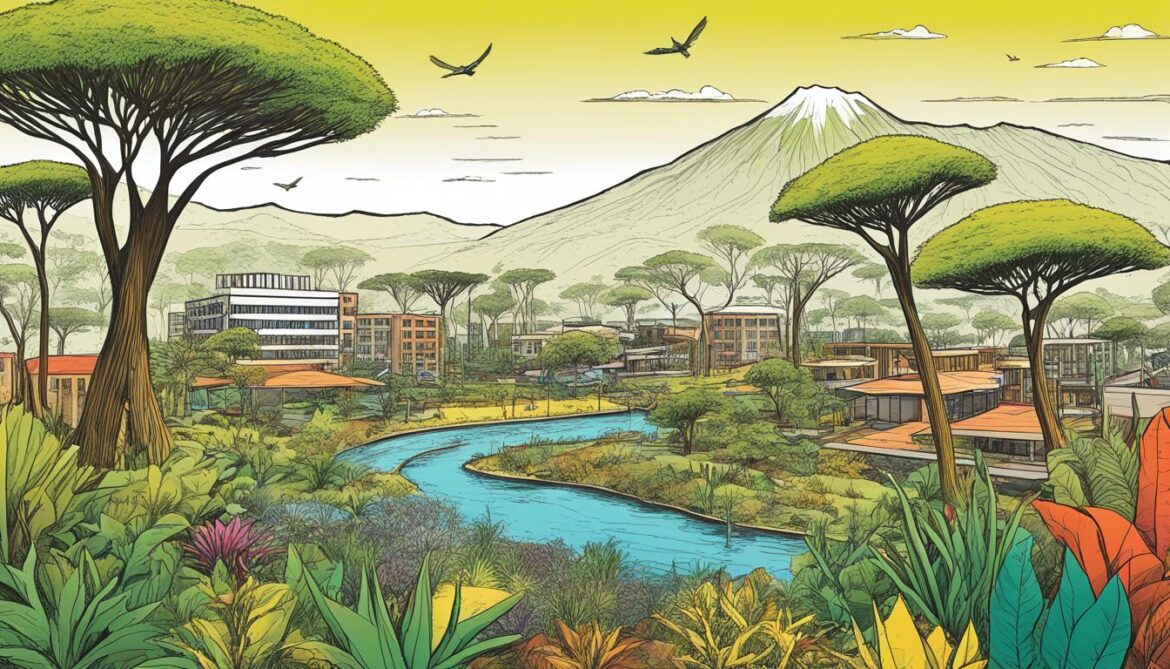
Conclusion
Tanzania faces several challenges in conserving its rich biodiversity, including weak institutions, unsustainable resource management, and poaching. However, the country remains determined to overcome these obstacles and ensure the preservation of its natural heritage, while fostering sustainable development.
Through various initiatives and development plans, Tanzania aims to strike a balance between biodiversity conservation and economic progress. The country recognizes the importance of implementing strategies that promote the responsible use of natural resources and the protection of fragile ecosystems.
Partnerships and collaborations, such as those with organizations like USAID, play a crucial role in supporting Tanzania’s efforts towards biodiversity conservation and sustainable development. By working together with international allies, the country can access valuable resources, expertise, and funding to enhance its conservation strategies and address the complex challenges it faces.
Tanzania’s ongoing commitment to protecting its diverse flora and fauna demonstrates its dedication to the welfare of current and future generations. By focusing on conservation initiatives, sustainable agriculture, and community-based efforts, the country strives to ensure the long-term viability of its natural resources, safeguarding the unique biodiversity that makes Tanzania a globally recognized treasure.



